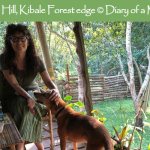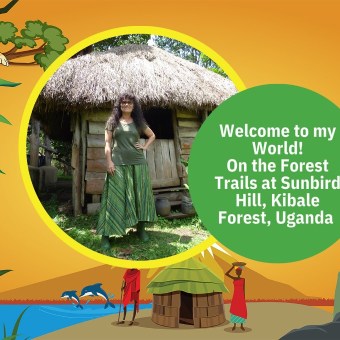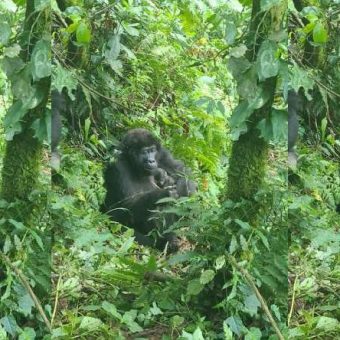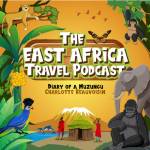
What is Big Birding Day?
It seems I can’t get enough of volunteering!
So, as Big Birding Day arrived, I was up before dawn to take part in this year’s 24 hour birding race (held to coincide with the World Bird Festival) entered by over 39 teams covering 33 sites across Uganda. Together we recorded 606 species.
And the best bit? Our team won!Uganda has more bird species per square kilometre than any other country in Africa. Uganda’s unique geographical positioning means there are more birds migrating north to Europe and back south to Southern Africa via Uganda than virtually any other African country.
The Big Birding Day race
It was a grey start to the day, the clouds gathering over Lake Victoria threatening rain. Our first birds of the day, at a grassy hill above Lweza, seemed to confirm the trend for the morning’s weather:
Grey-headed sparrow, Grey-backed Fiscals (nine of them), African Grey Parrot, Grey-backed Cameroptera, Grey Heron, Eastern Grey Plantain Eater.
I couldn’t help but smile as I jotted down birds with such picturesque names as:
Laughing Dove, Brown Twinspot, Helmeted Guineaufowl and Scaly Francolin.
The lucky team of me, Roger and Nathan, had almost made it back to the car as the heavens opened, ideal time for us to drive the few kilometres to the next site, the fish ponds at Kajjansi, where we saw two types of Sandpipers, Long-toed Lapwing, Broad-billed Roller, African Harrier Hawk, Fan-tailed Widowbird, Yellow-throated Longclaw and two types of Vulture.
As the rain passed our count moved to the quarry to spot a Eurasian Reed Warbler, Wattled Starling, a Grosbeak Weaver – spotted by yours truly – and the highlight of the day, a rare Red-necked Falcon, not recorded in Kampala for 25 years.
On a hill overlooking Lutembe Lagoon near Kajjansi airfield we derided the enormous flower farm, whose fertilisers leech unchecked into Lake Victoria. Lutembe is both a Ramsar site and IBA, Important Bird Area, recognised internationally for their unique biodiversity. Pollution of the waters should not be happening here of all places.
Ramsar sites are areas of wetlands which are among the world’s most productive environments. They are cradles of biological diversity, providing the water and primary productivity upon which countless species of plants and animals depend for survival. They support high concentrations of birds, mammals, reptiles, amphibians, fish and invertebrate species.
On the Papyrus fringed wetlands overlooking Kajjansi airfield our binoculars picked out many firsts for me: Sooty Chat, Striped Kingfisher, Little Bee-eater, the beautifully named Red-faced Lovebird, Blue-breasted Bee-eater, Lesser Swamp Warbler, Black-shouldered Kite, Black-crowned Waxbill, and Lizard Buzzard. Without the indefatigable Roger “no time to hang around” I would usually have been content to watch the Sunbirds, ignorant of the difference between a Copper Sunbird and a Bronze Sunbird. Roger’s observations were a real eye opener and made me forget the pre-dawn start!
Wandering around Zika Forest with a clipboard, I was delighted to see Red Tailed Monkeys – my totem – in the high trees above us. One of them tutted at us loudly. “We don’t have time for mammals” a disappointed Roger scolded. It was as we left the Forest that we had the most bird sightings and Roger’s mood lifted. We were delighted to see Purple Headed Starlings and a Red-shouldered Cuckoo-shrike, rare visitors to Kampala and its environs.
As we drove onto the Entebbe peninsula, through the narrow tunnel underneath the airport runway, a lady skirted the perimeter fence, balancing several metres of firewood on her head. The sight seemed incongrous, the juxtaposition of the traditional and the supersonic.
With all the birds noted down, my binoculars strayed to the man in his underpants, fishing in the shallows…
“Charlotte, stop looking at that naked man!” Roger shouted.
There were more monkeys waiting for us at Entebbe’s Botanical Gardens: both Vervet and Black and White Colobus. (I had to admire the bravery of the nut seller who casually walked beneath a tree full of monkeys with his open basket of groundnuts).
Tired, but happy we’d secured a good score, we drove back to Kampala so Roger could start comparing scores with the other teams. Big Birding Day Uganda was a fantastic day out. Roger and Nathan introduced me to a whole new range of birds and some fabulous habitats (sewage ponds excepted!)
A successful day – the official word
Teams recorded birds in all National Parks, Wildlife reserves, Important Bird Areas, Ramsar sites and Forest reserves and included community groups, groups of tourists, teams from NatureUganda, Uganda Wildlife Authority, Uganda Bird Guides Club and more. The highest record came from Kampala-Entebbe area with 175 species (that was us!), followed by Murchison Falls National Park (162), Queen Elizabeth National Park (160), Kidepo National Park (150), Mabamba Ramsar site (138), Bwindi Impenetrable Forest National Park (137), Mabira Forest Reserve (136), Bahai Temple-Park Alexander, Kampala (126), Kibale National Park (110), Lake Mburo National Park (110).
During the day, a number of key species were recorded that have not been documented on the Ugandan (bird) list for over 50 years and were about to be removed from the list; species that are not on the Uganda list at all and those that have over time extended their ranges to areas where they have not been recorded before.
Based on the Big Birding Day Uganda race, NatureUganda plan to develop a tour of Uganda that birders – from Uganda or from overseas – can follow to record the highest number of species. Birding is important for the development of Uganda’s tourism industry, with the potential for it being an even bigger revenue earner than gorilla tourism.
So what’s Ramsar all about?
The Ramsar Convention on Wetlands: Uganda presently has 12 sites designated as Wetlands of International Importance, with a surface area of 454,303 hectares.
Lutembe Bay Wetland System. 15/09/06; Wakiso; 98 ha; 00°10’N 032°34’E. Important Bird Area. Situated at the mouth of Lake Victoria’s Murchison Bay, this shallow area is almost completely cut-off from the main body of Lake Victoria by a C. papyrus island. The site supports globally threatened species of birds, endangered Cichlid fish, and over 100 butterfly species, including three rare ones. It is a breeding ground for Clarias and lungfish, and regularly supports more than 52% of the White-winged Black Terns (Chlidonias leucopterus) population. The system plays an important hydrological role, with the swamps surrounding the Murchison Bay acting as natural filters for silt, sediments and excess nutrients in surface run-off, waste waters from industries, and sewage from Kampala City. Lutembe Bay is being reclaimed and decimated for horticultural activities and the surrounding highly populated areas have been strongly affected by commercial and industrial development, urban wastewater, and conversion to agricultural land. A number of NGOs have been conducting conservation education activities in and around Lutembe, with the Uganda Wildlife Education Center (UWEC) only about 5 km from the bay. Ramsar site no. 1637.
Do you want to take part in Big Birding Day in 2013? The event is growing bigger and bigger every year and Diary of a Muzungu is delighted to be one of the media sponsors.
To register for Big Birding Day, visit NatureUganda or the Uganda Wildlife Authority websites.
If you like birds, check out the Muzungu’s Birds page for lots more Ugandan birding stories!

































We used to live on the south coast of England, only a few miles from Arundel where one of the Wildfowl and Wetlands Trust sites is situated.
The WWT has six sites in the UK that are RAMSAR sites – at Caerlaverock, Martin Mere, Llanelli, Welney, Castle Espie, and at the trust’s headquarters at Slimbridge.
We are big supporters of WWT and of the late Peter Scott, the driving force behind its establishment of these sites.
Do check them out at http://www.wwt.org.uk/
David (fellow Sherpie)
Thanks for the comment and the link David. I’m going to put Nature Uganda in contact with them, might be useful.
Oh that Uganda was as well disciplined on environmental matters as the UK. We Brits bemoan the regulations but at last they have a positive impact – just look at how clean the UK’s rivers are now. (Tho some would argue that since we’ve relocated all our manufacturing to China, we’ve simply shifted the problem).
Tx again!
Charlotte